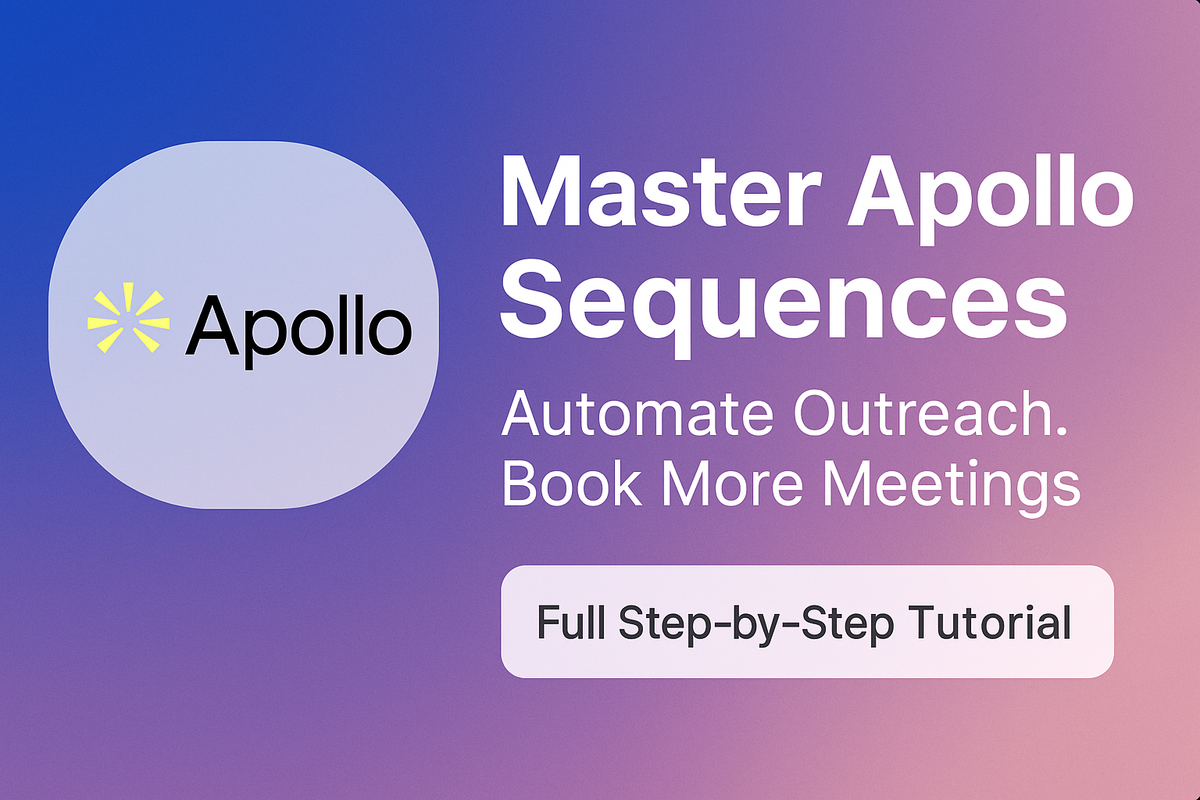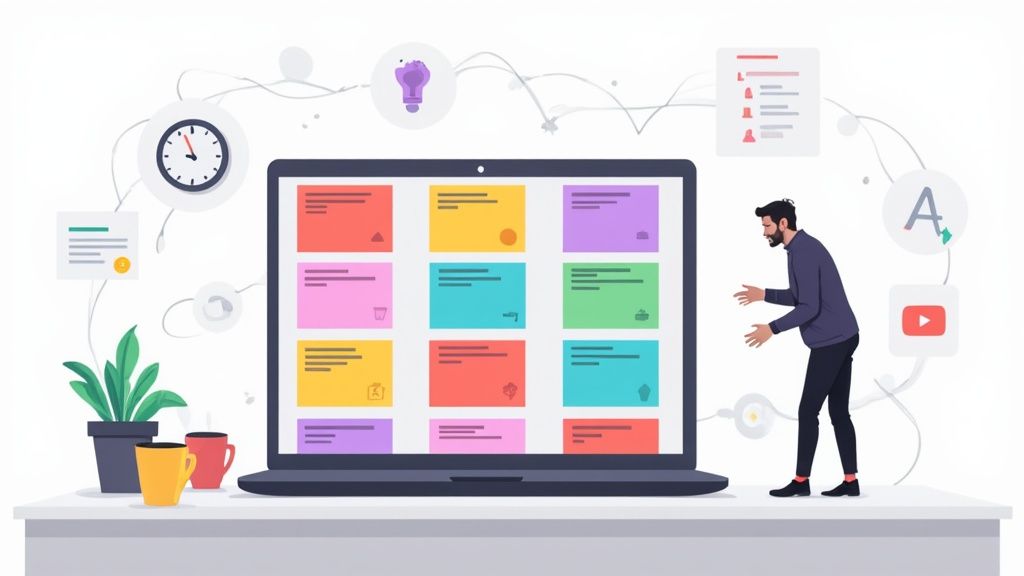Apollo.io Sequences: The Ultimate Guide to Automated Outreach for B2B Sales
Master Apollo Sequences to automate cold outreach, personalize follow-ups, and boost replies. Full tutorial + templates inside.

Answer first: Apollo.io Sequences are automated outreach campaigns that schedule emails, calls, LinkedIn actions, and tasks so prospects are contacted consistently without manual follow ups. They help you scale outreach, personalize at speed, and avoid missed follow ups.
Following up manually is slow, inconsistent, and easy to mess up. The Apollo sequencer fixes that, automating email, LinkedIn, and calls so leads do not slip through the cracks.
Quick start: Open a free Apollo.io account and use the step by step guide below.
Table of contents
- What are Apollo.io Sequences
- How to create a sequence in Apollo step by step
- Sequence rulesets and default triggers
- LinkedIn tasks inside a sequence
- A/B testing sequences
- Deliverability, mailbox rotation, and safe send rates
- How many touches and the email to call ratio
- Useful utilities, archive or delete, change mailbox
- Best practices and a 5 step sequence template
- FAQ
- Launch your first sequence
What are Apollo.io Sequences
Apollo.io sequences are multi step outreach campaigns. You define the steps, timing, and channels, then Apollo runs them and pauses or finishes contacts based on your rules.
- Emails automated or manual
- Phone calls with tasks and notes
- LinkedIn tasks view profile, connect, message, interact with posts
- Manual tasks to keep non email actions organized
Why it matters consistency and scale. Sequences keep you top of mind and free up time to hold real conversations.
How to create a sequence in Apollo step by step
Step 1. Plan your campaign
- Choose one persona or segment
- Define one outcome, reply or booked call
- Write a single value proposition and one clear CTA
Step 2. Create a new sequence
- Go to Sequences, click New sequence.
- Name it and set schedule, time zone, and business hours.
Step 3. Add steps and channels
Mix automated emails, manual emails, calls, LinkedIn actions, and tasks. Keep gaps realistic, for example 1 to 3 days between touches.
Step 4. Write the messages
Use dynamic fields such as {{first_name}} and {{company}}. Draft two subject lines and two body variants per email to test different angles, for example pain, value first, question, proof.
Step 5. Enroll prospects
Add contacts from a saved search, list, CSV, or Apollo’s database. Select the mailbox to send from or set mailbox rotation if available on your plan.
Step 6. Launch and monitor
- Toggle steps on and click Start sequence.
- Track opens, replies, bounces, and task completion.
- Pause or finish contacts based on outcomes.
Try it now: Start your Apollo.io trial and follow the six steps above.
Sequence rulesets and default triggers
Rulesets control safety and behavior. Common defaults include:
- Finish on reply stop remaining steps when a contact replies
- Pause on out of office resume after the OOO period if detected
- Finish on booked meeting end the sequence when a calendar event is set
You can adjust defaults inside ruleset settings. Use rulesets to keep sequences compliant and respectful.
LinkedIn tasks inside a sequence
LinkedIn steps help warm up email. Typical tasks you can add:
- View profile for quick research
- Send connection request with a short, specific note
- Send message after you have some engagement
- Interact with a post like or thoughtful comment
Install the Apollo Chrome extension, then complete or batch execute LinkedIn tasks from your queue. Sales Navigator is not required for basic tasks.
A/B testing sequences
Inside any automated email step, create multiple templates to test subject lines, openers, CTA placement, and tone. Start simple with two variants. Keep the winner and iterate each week.
Deliverability, mailbox rotation, and safe send rates
- Authenticate your domain and connect the mailbox correctly.
- Ramp volume slowly, especially on new domains and mailboxes.
- Early send limits about 50 emails per day per mailbox and 5 to 6 per hour is a safe starting point. Increase gradually while bounce and spam signals stay low.
- Mailbox rotation can spread volume across mailboxes and reduce risk if your plan includes it.
- Monitor bounces fix bad addresses, then retry and continue the sequence.
How many touches and the email to call ratio
There is no single magic number. A practical starting point is 8 to 12 total touches across email, calls, and LinkedIn during 10 business days to three weeks. Teams often see better response when they mix channels rather than relying on email only.
Ratios to try 3 emails, 3 to 4 calls, 1 to 2 LinkedIn touches in the first cycle, then shift to a lighter monthly nurture for non responders.
Useful utilities
Archive or delete a sequence
Use Archive to retire a sequence and keep your list clean. You can later filter by status and Unarchive. When a sequence is archived, remaining scheduled emails are removed, so archive only when you are done with it.
Change the sending mailbox for contacts in a sequence
Open the sequence, go to Contacts, select contacts, click the three dots menu, choose Email from different user, pick a mailbox, and save. The sender name follows the mailbox owner profile.
Scheduling days and hours
Set business hours and weekdays only if you want to avoid weekends. Sticking to local business hours often improves reply quality.
Best practices and a 5 step sequence template
Best practices
- Single persona avoid mixing ICPs in one sequence
- Personalize beyond name mention funding, hiring, tools, or a page on their site
- Short emails 50 to 125 words, one clear CTA
- Mix channels add a quick profile view and one call to lift replies
- Test weekly subject lines first, then openers and CTA position
Example, 5 step cold outreach sequence
| Step | Channel | Message focus | Delay |
|---|---|---|---|
| 1 | Short intro and clear value | Day 1 | |
| 2 | Connection request and profile view | Day 2 | |
| 3 | Short case proof or customer outcome | Day 4 | |
| 4 | Call | Direct ask for 15 minute call, leave voicemail | Day 6 |
| 5 | Breakup note with soft CTA | Day 10 |
Related reads Cold Email That Does Not Feel Like Cold Email, a 2025 Playbook and Amplemarket vs Apollo.io.
FAQ
What happens when a lead replies in an automated sequence?
By default, reply detection finishes the contact or pauses progress depending on your ruleset. You can change that behavior in ruleset defaults.
Can I run sequences on weekends?
Yes, you can, although most teams set weekdays only for better reply quality.
Can I A/B test emails inside a sequence?
Yes. Add multiple templates in an automated email step to test subject lines, openers, CTA placement, and tone.
Does Apollo have an AI sequence generator?
Yes. You can generate a draft sequence and edit the steps and copy before launch.
Where do plan limits and pricing apply?
Features vary by plan and change over time. Check the latest plan details inside your Apollo workspace when you create or edit a sequence.
Launch your first sequence
Create a simple 5 to 7 step sequence, enroll 25 to 50 contacts, and review results after one week. Start with Apollo.io here.





